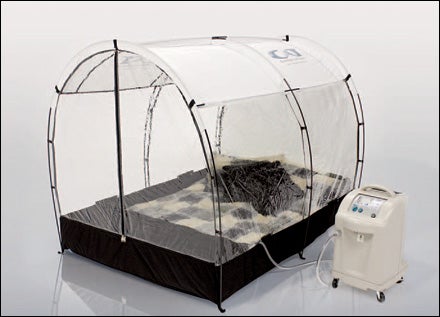Top endurance athletes have long known that snoozing inside oxygen chambers—which can be set to mimic the thin-air conditions at high altitudes—can help improve aerobic fitness by boosting the blood’s oxygen-carrying capacity. But now there’s another oxygen-manipulation therapy gaining adherents. Superoxygenated hyperbaric chambers, which infuse more oxygen into the air, are the new rage among athletes hoping to speed the recovery of sore muscles and soft-tissue injuries. So are you better off napping on a simulated Mount Fuji summit or a fake Death Valley? The answer depends on what your goals are. Take a deep breath and check out our primer below.
Hyperbaric Chamber
A technician seals you inside an eight-foot-long chamber, increases air pressure to twice that at sea level, and pumps in 100 percent oxygen—instead of the 21 percent found at the beach.
HEALTH BENEFITS: Called hyperbaric oxygen therapy (HBOT), a one-hour session in the chamber constricts blood vessels, decreasing swelling in injured areas. Despite the reduced flow, the red blood cells carry more oxygen to the damaged tissues, due to the hyperoxygenated air. This is thought to help speed recovery of muscle and connective-tissue injuries. It may also increase the white blood cells’ ability to attack infection-causing bacteria.
DRAWBACKS: Prolonged exposure can lead to oxygen toxicity and seizures—which occur in one out of every 10,000 uses. If overdone, HBOT increases the number of cancer-causing free radicals in the body. Plus it’s highly flammable in there: A spark will ignite a fire- storm—so leave the wool socks at home.
USERS: Besides pop-star wreck Michael Jackson? Athletes in sports with high injury rates, like NFL stars Michael Vick and Jeremy Shockey and NHL center Sergei Federov.
COST: $150–$600 per session
INFO: 800-973-3009,
High-Altitude Chamber
Via either a pressurized bedroom, 64-square-foot cubicle room, or portable tent, oxygen levels are reduced to simulate the thin air at altitudes of 7,000 to 12,500 feet. Users sleep in the space six to nine hours a day for maximum effectiveness.
HEALTH BENEFITS: Lower oxygen levels stress the cells, causing them to produce higher levels of hemoglobin—the red blood cells that carry oxygen to muscles—and more enzymes to extract the oxygen from the blood, so the body can convert it to energy. The result? More oxygen for your body to use as energy, which means more power, endurance, and speed.
DRAWBACKS: Prolonged oxygen depletion—more than a month straight—breaks down muscle tissue. And chambers aren’t cheap.
USERS: Lance Armstrong and two-time Ironman champ Tim DeBoom. In general, cyclists, triathletes, and high-altitude climbers gain the most from this approach.
COST: $5,845–$7,700 per chamber INFO: 877-258-4883,


